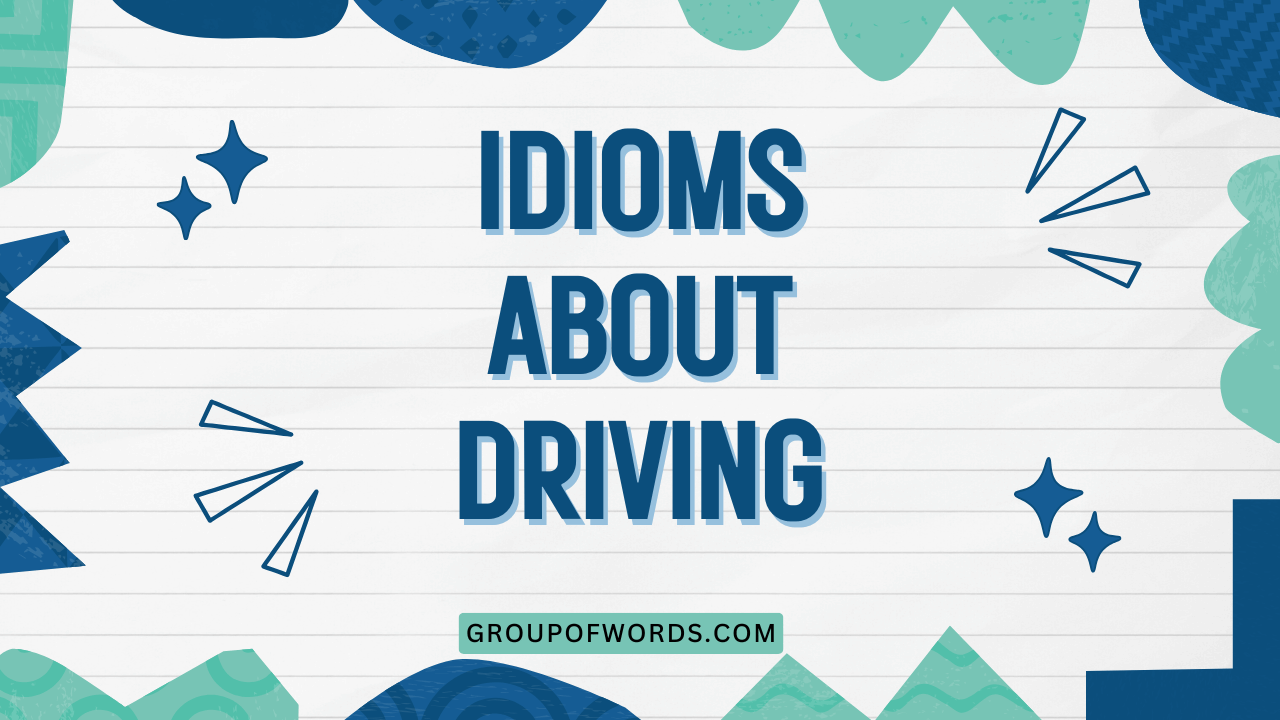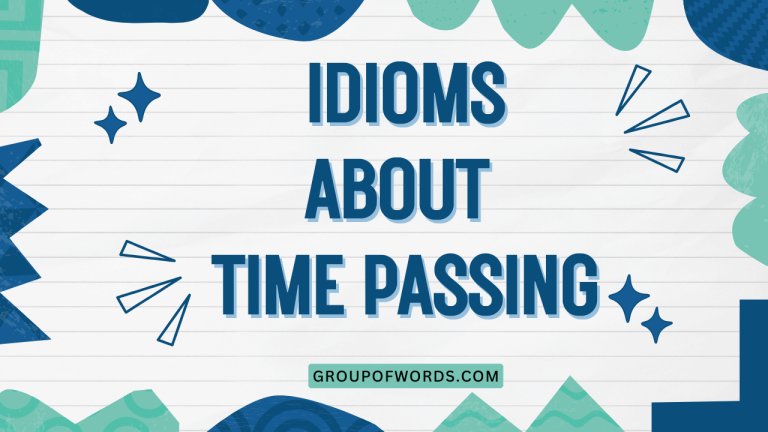Driving Idioms: Mastering Everyday English Expressions
Understanding idioms is crucial for mastering English, especially in everyday conversations. Idioms about driving are particularly common, reflecting how integral cars and transportation are to modern life.
This article provides a comprehensive guide to these idioms, explaining their meanings, origins, and usage. Whether you’re an ESL student, a language enthusiast, or simply looking to improve your English fluency, this guide will help you navigate the colorful world of driving idioms with confidence.
Table of Contents
- Introduction
- What are Driving Idioms?
- Structural Breakdown of Driving Idioms
- Types and Categories of Driving Idioms
- Examples of Driving Idioms
- Usage Rules for Driving Idioms
- Common Mistakes with Driving Idioms
- Practice Exercises
- Advanced Topics in Driving Idioms
- Frequently Asked Questions
- Conclusion
What are Driving Idioms?
Driving idioms are expressions that use driving-related terms to convey meanings beyond their literal definitions. These idioms often describe situations, behaviors, or emotions.
Understanding them is essential for interpreting spoken and written English accurately, as they add color and depth to communication. They reflect cultural attitudes towards driving, travel, and life in general.
Mastering these idioms enhances both comprehension and expressive abilities in English.
Structural Breakdown of Driving Idioms
Driving idioms typically consist of a combination of words that, when taken literally, do not make sense in the given context. They often involve verbs, nouns, and prepositions related to driving.
Analyzing their structure helps in understanding their figurative meanings. The key is to recognize that the individual words contribute to a larger, non-literal meaning.
Many driving idioms are metaphorical, drawing parallels between driving experiences and life situations. For example, “hit the road” uses the literal action of starting a journey to mean beginning any kind of endeavor.
The structure can be broken down into several components: the driving-related term (e.g., “road,” “wheel,” “gear”), the verb associated with it (e.g., “hit,” “take,” “shift”), and any additional words that complete the phrase and provide context. Recognizing these components allows learners to deconstruct and interpret new idioms more effectively.
Often, the emotional or behavioral context is implied rather than explicitly stated, requiring the listener or reader to infer the intended meaning.
Types and Categories of Driving Idioms
Driving idioms can be categorized based on the specific aspect of driving they relate to. These categories include idioms related to speed, direction, control, and common problems encountered while driving.
Understanding these categories can help learners grasp the nuances of each idiom and use them appropriately.
Speed-Related Idioms
These idioms use the concept of speed to describe the pace of progress or the intensity of an action. They often convey a sense of urgency or efficiency.
Direction-Related Idioms
Direction-related idioms employ terms like “road,” “path,” and “way” to symbolize life choices, decisions, and overall direction in life.
Control-Related Idioms
Control-related idioms use terms like “wheel,” “driver’s seat,” and “brake” to represent influence, responsibility, and restraint in various situations.
Problem-Related Idioms
Problem-related idioms use terms like “crash,” “bump,” and “stuck” to describe difficulties, setbacks, and challenges encountered in life or projects.
Examples of Driving Idioms
Below are examples of driving idioms, categorized to illustrate their diverse meanings and usages. Each idiom is accompanied by an explanation and example sentences to provide context.
Common Driving Idioms
These are some of the most frequently used driving idioms in everyday English.
The following table provides examples of common driving idioms, their meanings, and example sentences.
| Idiom | Meaning | Example Sentence |
|---|---|---|
| Hit the road | To start a journey or leave a place. | It’s getting late; we should hit the road. |
| Behind the wheel | In control or responsible for something. | She’s behind the wheel of the entire project. |
| Take for a spin | To try something out or give it a test run. | Let’s take this new software for a spin. |
| Life in the fast lane | A life full of excitement and risk. | He’s been living life in the fast lane since he moved to the city. |
| Road hog | Someone who takes up more than their fair share of space or resources. | Don’t be a road hog; share the office supplies. |
| Backseat driver | Someone who offers unwanted advice, especially when not in control. | I hate being a backseat driver, but I think you should turn here. |
| Smooth sailing | Easy progress without problems. | After the initial hiccups, the project was smooth sailing. |
| At a crossroads | At a point where one has to make a crucial decision. | He’s at a crossroads in his career, unsure of what to do next. |
| Burn rubber | To accelerate quickly. | The car burned rubber as it sped away from the scene. |
| Pump the brakes | To slow down or reconsider. | You should pump the brakes on that investment; it seems risky. |
| In the driver’s seat | In control of a situation. | Now that I’m in the driver’s seat, things are going to change. |
| Run out of gas | To run out of energy or resources. | I’ve run out of gas on this project; I need a break. |
| Lose steam | To lose enthusiasm or energy. | The project lost steam after the initial excitement. |
| Change gears | To shift focus or approach. | Let’s change gears and discuss the marketing strategy. |
| Full throttle | With maximum effort or speed. | We’re going full throttle to meet the deadline. |
| Spin one’s wheels | To waste time and energy without making progress. | They’re just spinning their wheels trying to fix the problem without a clear plan. |
| Off the beaten path | Away from the usual or popular routes. | We decided to explore some restaurants off the beaten path. |
| Come to a screeching halt | To stop suddenly and abruptly. | The negotiations came to a screeching halt when they couldn’t agree on the terms. |
| Back on track | Returning to the intended course or plan. | After a few setbacks, we’re finally back on track. |
| Clear the road | To remove obstacles or make way for progress. | We need to clear the road for innovation. |
| Drive someone up the wall | To annoy or irritate someone greatly. | His constant complaining is driving me up the wall. |
| Jump the gun | To act prematurely or before the appropriate time. | They jumped the gun by announcing the product before it was ready. |
| Miss the boat | To miss an opportunity. | If you don’t apply now, you might miss the boat. |
Speed-Related Idioms
These idioms often use the concept of vehicular speed to describe the pace or intensity of an activity or situation.
The following table provides examples of speed-related driving idioms, their meanings, and example sentences.
| Idiom | Meaning | Example Sentence |
|---|---|---|
| Full speed ahead | To proceed with maximum effort and speed. | With the project approved, it’s full speed ahead. |
| Slow down | To reduce the pace or intensity. | You need to slow down and take a break; you’re working too hard. |
| Gain momentum | To increase in speed or force. | The campaign is starting to gain momentum. |
| Pick up speed | To accelerate or increase the pace. | The project picked up speed once we hired more staff. |
| At a snail’s pace | Very slowly. | The construction is moving at a snail’s pace. |
| In high gear | Operating at a high level of activity or efficiency. | The team is operating in high gear to meet the deadline. |
| Take the scenic route | To take a longer, more leisurely path. | Let’s take the scenic route and enjoy the view. |
| Racing against time | In a hurry to meet a deadline. | We are racing against time to finish the report. |
| Step on the gas | To accelerate or increase effort. | We need to step on the gas if we want to finish on time. |
| Idle | Not active or in use. | The machines were left idle during the holiday. |
| Cruise | To proceed smoothly and effortlessly. | After the initial challenges, the project is now cruising. |
| Fast track | To expedite or accelerate progress. | They were put on the fast track for promotion. |
| Hit top speed | To reach the maximum pace or efficiency. | The company hit top speed during the peak season. |
| One-way street | A situation where action or influence is only in one direction. | The relationship felt like a one-way street, with her always giving and him always taking. |
| Road to success | The path or process leading to achievement. | Hard work and dedication are key to the road to success. |
| Rev up | To increase energy or excitement. | The crowd revved up as the band took the stage. |
| Speed bump | A minor obstacle or delay. | The new regulation is just a speed bump in our plans. |
| Shift into high gear | To increase effort and efficiency. | We need to shift into high gear to meet the deadline. |
| Slow and steady wins the race | Consistent effort leads to success. | Remember, slow and steady wins the race when learning a new language. |
| Stop dead in one’s tracks | To stop suddenly and completely. | He stopped dead in his tracks when he heard the news. |
| Take it slow | To proceed with caution and at a relaxed pace. | Take it slow when learning a new skill. |
| Step on the gas | To accelerate or increase effort. | We need to step on the gas if we want to finish on time. |
Direction-Related Idioms
These idioms utilize navigational terms to describe life choices, paths, and overall direction.
The following table provides direction-related driving idioms, their meanings, and example sentences.
| Idiom | Meaning | Example Sentence |
|---|---|---|
| Lost in the shuffle | To be overlooked or forgotten in a busy environment. | Her application got lost in the shuffle. |
| Know the ropes | To understand the details of how something works. | He knows the ropes of the business. |
| Go the extra mile | To make an extra effort. | She always goes the extra mile for her clients. |
| Lose one’s way | To become confused or misguided. | He lost his way after facing several setbacks. |
| On the right track | Proceeding in a good direction. | The investigation is on the right track. |
| Wrong side of the road | To be mistaken or on the incorrect path. | He started his career on the wrong side of the road, but eventually found his passion. |
| Clear a path | To remove obstacles or make way for progress. | We need to clear a path for innovation. |
| Fork in the road | A point where a decision must be made. | He came to a fork in the road when deciding between two job offers. |
| Go around in circles | To be unproductive and repetitive. | We’re just going around in circles with this discussion. |
| Head in the right direction | Making progress towards a goal. | The project is heading in the right direction. |
| One-way street | A situation where action or influence is only in one direction. | The relationship felt like a one-way street, with her always giving and him always taking. |
| Road to success | The path or process leading to achievement. | Hard work and dedication are key to the road to success. |
| See the light at the end of the tunnel | To perceive an end to a difficult situation. | After months of hard work, we can finally see the light at the end of the tunnel. |
| Around the corner | Near or about to happen. | The holidays are just around the corner. |
| Back to square one | To start over from the beginning. | When the deal fell through, we were back to square one. |
| Get your bearings | To become oriented or familiar with a situation. | It took me a while to get my bearings in the new job. |
| Go off course | To deviate from the intended path. | The project went off course due to unforeseen circumstances. |
| Lead someone down the garden path | To deceive or mislead someone. | He led her down the garden path with false promises. |
| Make headway | To make progress. | We’re finally making headway on the project. |
| Move in the right circles | To associate with influential people. | He started moving in the right circles to advance his career. |
| On the horizon | Likely to happen soon. | New opportunities are on the horizon. |
| Straight and narrow | To live an honest and moral life. | He decided to stay on the straight and narrow after his past mistakes. |
Control-Related Idioms
These idioms use driving terms to represent control, responsibility, and influence in various situations.
The following table provides examples of control-related driving idioms, their meanings, and example sentences.
| Idiom | Meaning | Example Sentence |
|---|---|---|
| Take the wheel | To take control or responsibility. | It’s time for the younger generation to take the wheel. |
| At the helm | In a position of leadership or control. | She’s at the helm of the company. |
| Keep a tight rein | To maintain strict control. | The manager keeps a tight rein on expenses. |
| Lose control | To be unable to manage a situation. | He lost control of his emotions during the argument. |
| Steer clear of | To avoid something or someone. | You should steer clear of that area at night. |
| Jam on the brakes | To stop something suddenly. | They had to jam on the brakes when they saw the opportunity slipping away. |
| Keep both hands on the wheel | To stay focused and in control. | During the crisis, he kept both hands on the wheel. |
| Navigate the situation | To manage or guide a situation. | She skillfully navigated the situation to a successful outcome. |
| Run the show | To be in charge or control of something. | He runs the show at the company. |
| Call the shots | To make the decisions. | As the CEO, she calls the shots. |
| Have the upper hand | To have an advantage. | She has the upper hand in the negotiation. |
| Hold the reins | To be in control. | He holds the reins of the organization. |
| Pull the strings | To control a situation from behind the scenes. | Someone is pulling the strings to make this happen. |
| Rule the roost | To be in charge. | She rules the roost in her household. |
| Take charge | To assume control. | She took charge of the project when the leader resigned. |
| Wear the pants | To be the dominant person in a relationship. | She wears the pants in their marriage. |
| Call the tune | To be in control and make the decisions. | He who pays the piper calls the tune. |
| Clamp down on | To take strict measures to prevent something. | The police are clamping down on illegal activities. |
| Curtain call | The final recognition of success. | After the successful launch, it was time for the curtain call. |
| Drive a hard bargain | To negotiate aggressively. | She drives a hard bargain when negotiating contracts. |
| Hold all the cards | To have all the advantages. | He holds all the cards in this negotiation. |
| Keep in line | To maintain order and discipline. | The teacher tries to keep the students in line. |
Problem-Related Idioms
These idioms use driving terms to describe difficulties, setbacks, and challenges.
The following table provides examples of problem-related driving idioms, their meanings, and example sentences.
| Idiom | Meaning | Example Sentence |
|---|---|---|
| Hit a bump in the road | To encounter a minor problem or obstacle. | We hit a bump in the road, but we’re working to resolve it. |
| Crash and burn | To fail spectacularly. | The project crashed and burned due to poor planning. |
| Dead end | A situation with no way out or no future prospects. | The investigation reached a dead end. |
| Get stuck in a rut | To become trapped in a monotonous routine. | He felt like he was getting stuck in a rut at his job. |
| Run into a brick wall | To encounter an insurmountable obstacle. | We ran into a brick wall when trying to get funding. |
| Skid to a halt | To come to an abrupt stop due to problems. | The negotiations skidded to a halt. |
| Broken down | Not functioning correctly or effectively. | The system broken down after the update. |
| End of the road | The conclusion or end of something. | For that company, it was the end of the road. |
| Fall off the wagon | To relapse or revert to a bad habit. | He fell off the wagon after months of sobriety. |
| Go downhill | To deteriorate or worsen. | The business started to go downhill after the new management took over. |
| Go up in flames | To fail spectacularly. | The deal went up in flames due to disagreements. |
| Hit rock bottom | To reach the lowest possible point. | He hit rock bottom before turning his life around. |
| In a jam | In a difficult situation. | We’re in a jam because we need to finish the project by tomorrow. |
| On the rocks | Experiencing difficulties. | Their marriage is on the rocks. |
| Out of gas | Lacking energy or motivation. | I’m out of gas and need a vacation. |
| Run aground | To encounter a problem that stops progress. | The negotiations ran aground due to disagreements. |
| Sink or swim | To succeed or fail on one’s own. | They were left to sink or swim in the new job. |
| Stuck in the mud | Unable to make progress. | The project is stuck in the mud because of bureaucracy. |
| Tire blows out | To experience sudden failure. | The deal’s tire blew out at the last minute. |
| Up the creek without a paddle | In a difficult situation with no way out. | Without funding, we’re up the creek without a paddle. |
| Wreck havoc | To cause widespread destruction or disruption. | The storm wreaked havoc on the coastal towns. |
Usage Rules for Driving Idioms
Using driving idioms correctly requires understanding their specific meanings and contexts. While they add color to language, misusing them can lead to confusion.
It’s essential to consider the audience and the formality of the situation. In formal writing or presentations, it’s often better to use more direct and literal language.
However, in casual conversations or informal writing, driving idioms can be highly effective.
Pay attention to the nuances of each idiom. Some idioms are interchangeable, while others have very specific applications.
For example, “hit the road” and “take off” both refer to starting a journey, but “hit the road” typically implies a longer trip, while “take off” can refer to a shorter departure. Additionally, ensure that the tense of the idiom matches the context of the sentence.
For instance, use “hit the road” when referring to a future action and “hit the road” when referring to a past action.
Common Mistakes with Driving Idioms
One common mistake is taking driving idioms too literally. For example, misunderstanding “pump the brakes” as a literal instruction when it means to slow down or reconsider.
Another mistake is using idioms in inappropriate contexts, such as in formal academic writing. Additionally, learners sometimes create their own variations of idioms, which can sound awkward or incorrect.
Always use idioms as they are commonly expressed.
Another frequent error involves using the wrong preposition or verb tense. For instance, saying “in the driver seat” instead of “in the driver’s seat.” Similarly, using the wrong form of the verb, such as “hitting the road” instead of “hit the road” when the context requires the past tense.
It’s crucial to pay attention to these details to ensure accurate and effective communication.
| Incorrect | Correct | Explanation |
|---|---|---|
| He is on the wheel. | He is behind the wheel. | “Behind the wheel” means in control. |
| They will hit road tomorrow. | They will hit the road tomorrow. | “Hit the road” is the correct idiom. |
| She told to pump the brake. | She told me to pump the brakes. | “Pump the brakes” means to slow down. |
| He is living the fast life. | He is living life in the fast lane. | “Life in the fast lane” is the correct idiom. |
| They are spinning wheel. | They are spinning their wheels. | “Spinning their wheels” means wasting time. |
| He is in a crossroad. | He is at a crossroads. | “At a crossroads” is the correct idiom. |
| She is in the control seat. | She is in the driver’s seat. | “In the driver’s seat” means in control. |
Practice Exercises
Test your understanding of driving idioms with these practice exercises. Choose the correct idiom to complete each sentence.
Exercise 1: Fill in the Blanks
Choose the correct idiom from the list below to complete each sentence.
Idiom List: hit the road, behind the wheel, take for a spin, life in the fast lane, backseat driver, smooth sailing, at a crossroads, pump the brakes, in the driver’s seat, run out of gas
- We need to __________ if we want to arrive on time.
- She’s __________ of the company now, so she makes all the decisions.
- I think you should __________ on that investment; it seems risky.
- He’s been living __________ since he moved to New York.
- The project was __________ after the initial challenges.
- He’s __________ in his career, unsure of what to do next.
- Don’t be a __________; let him drive the way he wants to.
- I’ve __________ on this project; I need a break.
- Let’s __________ this new software and see how it works.
- She’s __________ of the entire operation.
Exercise 2: Multiple Choice
Choose the best meaning for each driving idiom.
- “Full speed ahead” means:
- a) To stop immediately
- b) To proceed with maximum effort
- c) To move slowly
- “Off the beaten path” means:
- a) A well-known route
- b) A dangerous road
- c) Away from the usual routes
- “Hit a bump in the road” means:
- a) To have an accident
- b) To encounter a minor problem
- c) To find a shortcut
- “Spin one’s wheels” means:
- a) To make progress
- b) To waste time and energy
- c) To drive recklessly
- “Steer clear of” means:
- a) To follow closely
- b) To avoid something
- c) To take control
- “Back on track” means:
- a) Lost and confused
- b) Returning to the intended course
- c) Driving in reverse
- “At the helm” means:
- a) In a position of leadership
- b) Lost at sea
- c) In a difficult situation
- “Run into a brick wall” means:
- a) To find a solution
- b) To encounter an obstacle
- c) To make rapid progress
- “Change gears” means:
- a) To stay the same
- b) To shift focus or approach
- c) To stop completely
- “Lose steam” means:
- a) To gain energy
- b) To lose enthusiasm
- c) To keep going
Exercise 3: Sentence Completion
Complete the sentences using the appropriate form of the driving idiom provided.
- After months of hard work, we could finally (see the light at the end of the tunnel) __________.
- He decided to (stay on the straight and narrow) __________ after his past mistakes.
- The project (went off course) __________ due to unforeseen circumstances.
- She (drove a hard bargain) __________ when negotiating the contract.
- We (hit a bump in the road) __________ but we managed to overcome it.
- They had to (jam on the brakes) __________ when they realized they were going the wrong way.
- I am (running out of gas) __________ and need a vacation.
- She has (taken the wheel) __________ of the company after the CEO retired.
- The team is (working full speed ahead) __________ to meet the deadline.
- He (lost his way) __________ after facing several setbacks in his career.
Answer Key:
Exercise 1:
- hit the road
- in the driver’s seat
- pump the brakes
- life in the fast lane
- smooth sailing
- at a crossroads
- backseat driver
- run out of gas
- take for a
spin
- behind the wheel
Exercise 2:
- b) To proceed with maximum effort
- c) Away from the usual routes
- b) To encounter a minor problem
- b) To waste time and energy
- b) To avoid something
- b) Returning to the intended course
- a) In a position of leadership
- b) To encounter an obstacle
- b) To shift focus or approach
- b) To lose enthusiasm
Exercise 3:
- After months of hard work, we could finally see the light at the end of the tunnel.
- He decided to stay on the straight and narrow after his past mistakes.
- The project went off course due to unforeseen circumstances.
- She drove a hard bargain when negotiating the contract.
- We hit a bump in the road but we managed to overcome it.
- They had to jam on the brakes when they realized they were going the wrong way.
- I am running out of gas and need a vacation.
- She has taken the wheel of the company after the CEO retired.
- The team is working full speed ahead to meet the deadline.
- He lost his way after facing several setbacks in his career.
Advanced Topics in Driving Idioms
For advanced learners, exploring the etymology and cultural context of driving idioms can offer deeper insights. Many driving idioms have historical roots related to the evolution of transportation.
Understanding these origins can enhance appreciation and retention. Additionally, comparing driving idioms across different languages and cultures can reveal interesting similarities and differences in how people perceive travel and life journeys.
Another advanced topic is the use of driving idioms in literature and media. Analyzing how authors and filmmakers employ these idioms can provide a richer understanding of their symbolic meanings.
For instance, a character who is described as “spinning their wheels” might be portrayed as someone who is stuck and unable to make progress, adding depth to their characterization.
Frequently Asked Questions
Why are driving idioms so common in English?
Driving idioms are common because cars and transportation are integral to modern life. They provide a relatable framework for describing various situations, behaviors, and emotions.
Are driving idioms universal across all English-speaking countries?
While many driving idioms are widely understood, some may be more common in certain regions or countries. Familiarity with regional variations can enhance communication.
How can I improve my understanding of driving idioms?
Immerse yourself in English language content, such as books, movies, and conversations. Pay attention to how native speakers use driving idioms in different contexts.
Is it okay to use driving idioms in formal writing?
In general, it’s best to avoid driving idioms in formal writing. Opt for more direct and literal language to ensure clarity and professionalism.
What is the best way to memorize driving idioms?
Use flashcards, practice exercises, and real-life conversations to reinforce your understanding. Contextualizing idioms in sentences and stories can also aid memorization.
Conclusion
Mastering driving idioms is a valuable step towards enhancing your English language skills. These expressions add color, depth, and nuance to communication.
By understanding their meanings, origins, and usage rules, you can confidently navigate conversations and written materials. Whether you’re a language learner or a native speaker, exploring the world of driving idioms can enrich your linguistic repertoire and cultural awareness.
Keep practicing, and soon you’ll be “driving” your English with ease and confidence!






